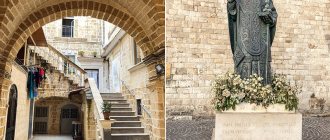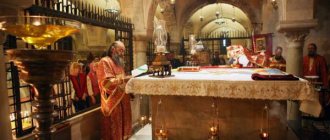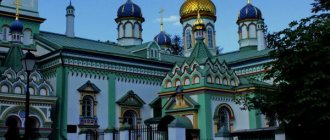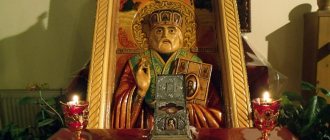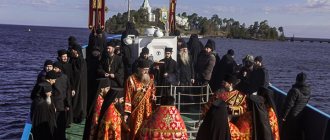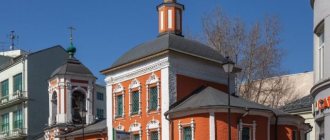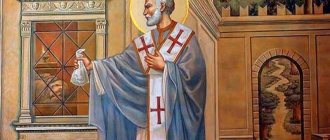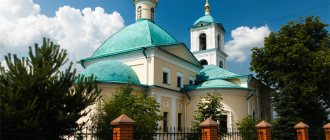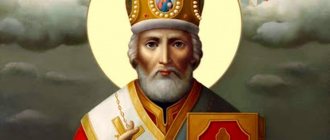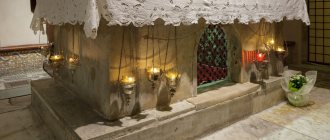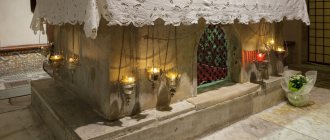Brief history of the saint's life
Svyatoch was born around 270 in the city of Patara, in the Lycian region (now the territory of modern Turkey).
His mother and father, Nonna and Theophanes, came from a noble and pious family and were very wealthy. But wealth and a noble title did not prevent them from being known as merciful to the poor and zealous in God’s prayer. For many years they prayed to the Creator to give them a son, and “in return” the couple promised to devote his life to serving God. Their prayer was heard and from Above the family was given a son, named Nicholas in Holy Baptism.
Nicholas the Wonderworker
The parents understood that their child was destined for special service to God, so they paid special attention to his upbringing, instilled Christian values and directed him on the righteous path.
Nikolai did well in his studies. He was not interested in conversations with his peers about worldly things; everything bad was alien to him. He avoided sinful entertainment, was chaste and spent his free time reading the Holy Scriptures, divine books, and prayed a lot.
Soon Nikolai was ordained a reader, and later a presbyter.
The Lord vouchsafed Nicholas to live to a ripe old age. At the end of his years, he became seriously ill and peacefully departed to Christ in the heavenly abode on December 6, 342. The burial took place in Myra in the cathedral church.
Temples consecrated in honor of Nicholas the Ugodnik:
- Cathedral of St. Nicholas the Wonderworker in Orenburg
- Church of St. Nicholas in Kuznetskaya Sloboda
- Cathedral of St. Nicholas in Evpatoria
History[edit]
The first mention of a wooden church dates back to 1625; in 1657 it was already made of stone, and in 1677 the church was already named by its full name, “St. Nicholas the Wonderworker at the Metropolitan’s Stables.”
The current church was founded somewhat apart from the original one on May 21, 1679 under Tsar Fyodor Alekseevich, and the consecration of the main temple took place on June 25, 1682. A single-pillar refectory with side chapels and a bell tower were added later.
In 1812, during the Patriotic War of 1812, the interior of the building was partially destroyed, but was restored by 1849. In 1845, wall paintings appeared in the temple. At the beginning of the 19th century, a fence and gate were erected.
The temple was restored in 1896, 1949 and 1972. Remained active all the time. From 1912 until his death in 1960, Candidate of Theology Archpriest Pavel Lepyokhin (1880−1960) served there continuously.
In 1992, a bell weighing 108 pounds was raised to the bell tower.
In 2008, the Church of St. Nicholas in Khamovniki celebrated the 160th anniversary of the transference and glorification under its arches of the miraculous image of the Mother of God “Helper of Sinners.”
Holy relics
700 years after the death of the pleasure-maker, devastation and devastation reigned in Lycia, this happened after the invasion of the Saracens - nomads, robbers, Bedouins.
Monks were on duty at the ruins of the temple, where the remains of the saint rested. In 1087, Nicholas came to one of the Bari presbyters in a sleepy vision and ordered his body to be urgently transferred to Bari. For this purpose, three ships were equipped, and the elders and noble townspeople settled on them under the guise of traders.
This precaution was necessary because the Venetians wanted to intercept the procession and bring the holy remains to their city.
The traders sailed through Egypt and Palestine, conducting trade business along the way so as not to arouse suspicion. Finally, they ended up in Lycia. They opened a snow-white marble tomb.
To the surprise of those present, it turned out to be filled to the brim with a fragrant ointment, and Nikolai’s body rested in it. The nobles were unable to take the heavy tomb with them, so they transferred the remains into the prepared ark and headed to their homeland.
Relics of St. Nicholas the Wonderworker in Bari, Italy
After 20 days, on May 9, 1087, they arrived in Bari. Here the Liturgy was served with a multitude of clergy, and the relics were placed in the Church of St. Eustathius. And after 2 years, the crypts of the new temple were consecrated in the name of St. Nicholas the Pleasant, and the remains were solemnly transferred there.
Important! The incorruptible body still streams myrrh, and many miracles are performed from it. With faith, the saint grants healing from bodily and physical ailments to those who are anointed, and drives away unclean spirits.
At the end of the 11th century, the holy relics of Nicholas the Wonderworker were transferred to the city of Bar.
Shrines[edit]
- Icon of the Mother of God “Helper of Sinners”
The image was kept in the Nikolo-Odriny Monastery, in the Oryol province. This icon was forgotten by everyone until the wife of one merchant, whose son was subject to severe seizures, came to the monastery and asked to serve a prayer service in front of the image of the “Helper of Sinners.” A prayer service was served, after which the sick two-year-old child recovered. After the incident, the icon was transferred to the monastery church, where in the future it repeatedly showed its miraculous power to those praying, and to this day it is kept in the St. Nicholas Monastery.
But in the Nikolo-Khamovnichesky Church there was a different image. In 1846, a hieromonk was sent from the Oryol monastery to Moscow to make a chasuble for the miraculous icon in the capital. He was sheltered by Lieutenant Colonel D.N. Boncheskul. Wanting to thank the owner for the hospitality shown, the hieromonk sent him a copy of the miraculous image, which was placed in the home icon case along with other icons. Soon people began to flock to this list from everywhere and received healing from the miraculous image.
An extraordinary shine and drops of oily moisture were noticed on the icon. They began to anoint the sick with this world, after which they became healthy. Seeing the miracles that occurred from the image, Dmitry Boncheskul donated the icon “Supportress of Sinners” to the St. Nicholas Church in Khamovniki.
- Icon of St.
Alexia (1688, isographer Ivan Maksimov)
- List of the Smolensk Icon of the Mother of God
(XVII century)
- Martyr icon.
John the Warrior (XVIII century)
How to apply to the remains
There are unspoken rules for applying to holy remains:
- when approaching the ruck, you should not rush, push, or crowd;
- It is not advisable to carry bags or packages with you;
- kissing a shrine with painted lips is prohibited;
- before approaching the shrine, you must bow twice from the waist and cross yourself, and make the third bow after applying;
- You can't kiss saints on the face.
Icon of St. Nicholas the Wonderworker
Biography
The birth of the future Wonderworker around 270. The family into which he was born was wealthy and lived in Lycia, in the city of Patara. Orthodox parents believed in the teachings of the Savior Christ. They saw their purpose in helping those in need. Nicholas spent a lot of time in the church with his uncle, rector Nicholas of Patarsky.
When he grew up, he was a reader, then a priest. When his parents died, he gave his fortune to the poor and decided to continue his church service. Soon he became the bishop of Myra in Lycia (today Demre, Antalya in Turkey).
The parishioners liked the new bishop due to his responsiveness and fairness. But he fought against paganism and was irreconcilable towards heretics.
Advice : it is worth honoring the Pleasant for his righteous life and miracles began during his lifetime.
Many legends have been preserved, and all the miracles that the Saint performed cannot be counted. For example:
- A terrible famine began in the city of Mir. The saint began to pray fervently, the city was saved.
- The saint always helped those at sea. Many sailors whose ships were wrecked were rescued.
- If there were people in prison who did not deserve punishment, he helped them with prayers. Somehow they found themselves free.
No one can give the exact date of death. It is only known that he was a very old man. Date of death between 345 and 351. By watching the film “The Miracle Worker” by Arkady Mamontov, which tells about the Archbishop of Myra in Lycia, you can learn a lot of useful and interesting things.
When preparing this article, materials from the website pravoslavie.guru were used.
How to get to the relics
The relics of the Holy Saint of God are located at the address: Italy, Bari, Basilica of St. Nicholas. It was built in the 11th century. People from all over the world find every opportunity to touch the shrine. There are also believers from Russia here.
As for pilgrimage, it became active in the 19th and early 20th centuries, when the Orthodox Church of St. Nicholas was built in Bari. The Old Town of Bari is three kilometers away. The new church has a wide courtyard that can accommodate a large number of believers from all over the world.
You can join a pilgrimage group by arriving in Bari in an organized manner. If you decide to get to Bari on your own, then transport links here are well developed:
- There is no direct air connection with Italy, so first you will have to fly to some Italian city or Germany, and only then to Bari, where the relics of the Wonderworker lie. It’s easier for Europeans because there are seasonal flights.
- Another way is rail transport.
- You can also travel from Italian cities by bus.
- Ferries run from Croatia, Montenegro, Albania, and the island of Corfu.
Take note : there are three important dates in the Orthodox calendar. The Nativity of the Holy Saint is celebrated on August 11th. Remembrance Day is considered December 19 - this is the date of death, and May 22 - the day of the transfer of holy relics. These days, all men bearing the name Nikolai celebrate their name day.
Despite the fact that Nicholas the Wonderworker lived and performed miracles many centuries ago, people continue to believe in him. Faith brings positive results. Many experienced the miracles that the holy saint gave them.
Watch how the relics of St. Nicholas the Wonderworker myrrh stream in the following video:
Meeting with a Saint
— There are many great shrines in Moscow churches. But if they bring, like now, the relics of St. Nicholas, one of the most famous and beloved saints in Russia, particles of whose relics are in many Moscow churches, everyone runs. For what?
- Well, look: a person very dear to you is coming to see you. You can probably wave to him from afar. Or you can come up and shake his hand.
A shrine is not just remains, things, miraculous icons or some objects that the saints used during their lifetime.
Everything connected with a shrine is an event connected with the life of a saint in the Kingdom of God, and perhaps with my life on earth.
And in this light, the question of why go to one shrine, parts of which are in other temples, takes on a new meaning.
I myself, to some extent, succumbed to this temptation and began to reason in the same “technological” way: to eat in one place, why run to another?
When the Belt of the Most Holy Theotokos was brought to us in Moscow in 2011, I also thought so at first: well, I serve, take communion, and venerate a piece of the Robe of the Theotokos in the Cathedral of Christ the Savior regularly. And when the Patriarchate sent me on obedience to talk with those standing in line at the Cathedral of Christ the Savior, and I touched the Belt, I realized: it’s the Mother of God who has arrived! The Most Holy Theotokos herself came to us! How can one not go and meet Her?
The fact that Her Belt was brought to Russia, and for the first time, is a story from Her life, a completely new story, an event that is happening here and now! Yes, She is present in Moscow and in other shrines, but for the first time Her Belt was taken from Vatopedi, Mount Athos, Her inheritance. It was She who took such care of us today and expressed her love in such a way!
I think it’s the same with the relics of St. Nicholas.
After all, for a Christian, time is a nonlinear category. When we celebrate the Annunciation, we do not just remember how more than 2000 years ago the Archangel Gabriel brought the Good News to the Virgin Mary and the whole world. We celebrate this as the Good News that the world receives again and again!
Like other holidays, like the Resurrection of the Lord, we not only remember at every liturgy, but partake of His resurrection.
For example, there are a lot of icons of the Mother of God, but each image of Her is an event in Her historical life, Her participation in the life of a person.
And the person feels this, although he cannot always explain why he wants to come so much, there seem to be no specific requests. But there is a joy of meeting.
I later thanked God very much for sending me there during those days. I looked at the people and thought that I would have been too lazy to come, would have sat and been smart, but when I saw everything, I realized what was happening, how insensitive I was.
“Many sincere believers are frightened by the very thought that they will have to “make their way” to the shrine, in the crowd, in the excitement, but they want to pray in silence and “without witnesses.”
— Do we also pray “without witnesses” at the liturgy? The word "liturgy" translated from Greek means "common cause." And there, by the way, there is a line for communion, sometimes a long one.
Of course, when during the liturgy you are pressed from all sides, this is not conducive to prayer. It is also understandable that Muscovites, tired of the crowds, want to be with God in silence. But therefore, there are no guidelines or instructions on this issue: when, who and which shrine should be visited.
If a church person has doubts, he can ask his confessor; if not, he acts as his heart tells him.
“Here a man visited Jerusalem, venerated many shrines, and then they also brought a shrine to Moscow - should he go “renew his grace”?
— Don’t we regularly pray, confess, and receive communion? When, after communion, we sin and lose grace, we regret our sins and bring repentance and are strengthened by the Holy Mysteries of Christ.
There is repetition in all this. All life in the Church is built according to a certain circle: daily, annual. Services and holidays are repeated.
Our human nature is entropic; it is human nature to forget, to cool down.
We now remember, we experience, and at some point, for strengthening and support, we again need to return to the same symbolic environment in order to again understand how to communicate with God.
We need to restore and renew our strength, cleanse our memory. It is no coincidence that the Holy Fathers call confession the second baptism, when a person’s peace is restored with God, with the Church.
— And if a person does not have a personal relationship with the saint whose relics were brought, there is no special feeling of closeness? But this saint is great, everyone comes. Can a person keep his distance or will it be somehow ungodly?
- It will be sincere. God sees our heart and understands better what is in our souls than we do ourselves. It is not always possible to understand whether it is necessary or not to go to the shrine.
Communication with God occurs on a deeply personal level, and each person is unique. And no one knows what exactly happens in the secret of communication of the soul with God.
What stage of a person’s relationship with God is now - who will answer this exactly? No diagrams are suitable here; they can only be guidelines.
One of my acquaintances considered the Belt’s arrival not only a PR, but still a kind of action. But he went to the Belt, while maintaining skepticism.
And when he kissed, the incredible happened to him: he felt such peace in his soul and the love of the Most Holy Theotokos for him that he could express almost nothing in words except exclamations: “How good!”
This is what we, Orthodox Christians, are sometimes afraid of, remembering the preservation of feelings, sobriety, etc. And then the defense did not work, it struck this skeptic, then he was so happy, like a child. This man has already been in the Church for many years.
But it’s good that we don’t know everything, because otherwise there would be a temptation to reduce everything to a diagram, to turn it into technology. God keeps the secret because He respects our freedom.
"St. Nicholas Street"
Date and time: May 15 at 16:00, May 19 at 12:00
Meeting point: exit from the Smolenskaya metro station, blue line
In ancient times, one of the most famous streets in the capital was popularly called by the name of St. Nicholas . At that time there were three churches named in his honor. In the early 1930s, the churches located on this street were demolished, but the memory of them is still alive. We are talking about Arbat . The tour will tell you about the history of this pedestrian street. Participants will find out which church the young ladies were brought to for viewings, and which church served Saturday liturgies in Greek.
"Nikoloyamskaya Sloboda"
Date and time: May 16 at 16:00, May 19 at 14:00
Gathering place: Kotelnicheskaya embankment, building 1/15, in front of the entrance to the Illuzion cinema
Moscow has the most churches named after St. Nicholas. And there are even two streets with the name of this patron in the city - one in Kitai-Gorod, and the second - Nikoloyamskaya - runs along the Yauza River. It is along this route that the excursion participants will walk and be told the history of this merchant area.
Relics of the Righteous Prince Dmitry Donskoy
Prince Dmitry Ioannovich Donskoy went down in history as the righteous winner of the Horde army, the pious defender of the Orthodox faith and the builder of the white stone Kremlin in Moscow.
In 1988, the blessed Grand Duke was canonized by the Local Council of the Russian Orthodox Church. The holy relics of Dmitry Donskoy are kept in the Archangel Cathedral of the Kremlin. The remains of members of his family are also located there.
